
(Click to enlarge. Photos: M.Andersen unless noted)
Second in a two-post series.
It’s a little bit dumb that urbanists in the United States talk so much about Europe but so rarely about South America.
Our southern neighbors, after all, are more like us in big ways. Almost none of South America’s cities have medieval cores; they too were built mostly in the auto age. South America’s national and racial identities are relatively new, like ours are, and diversity and immigration are parts of South American national identities in ways that long-developed parts of Asia, northern Africa and Europe don’t share.
Also, South American cities are laboratories of rapid change. Bogotá, Colombia’s biggest metro area, has added 4.8 million new residents since 1990 and is now approximately the population of Greater London. The only European city that comes close to that sort of growth is Istanbul.
Colombian cities are no more perfect than any city. But on my honeymoon there this summer, I came across lots of neat ideas for building human-friendly streets that were worth bringing back home to talk about.
Here they are.
1) Raised crosswalks
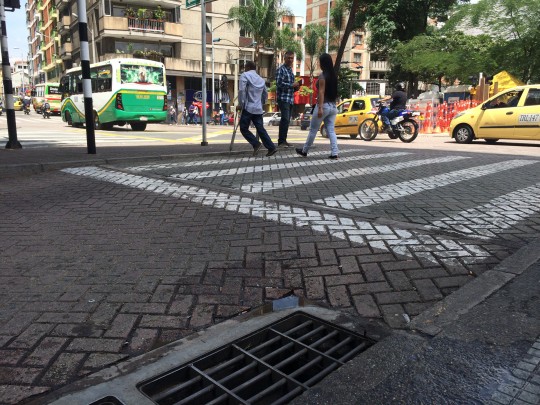
The United States has an organized movement to build more raised bike lanes. (I know because it’s my other gig.) Why doesn’t it have an organized movement to build raised crosswalks?
Raised crosswalks are fantastic.
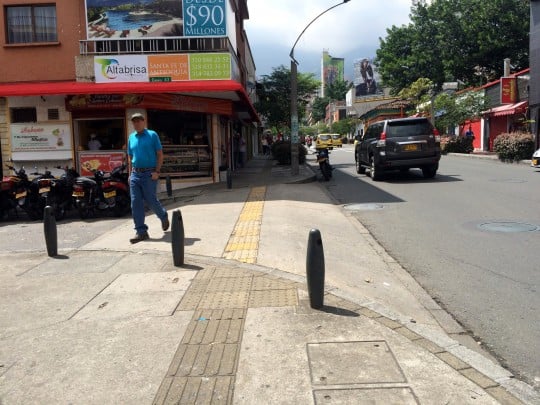
Just as Colombia has embraced protected bike lanes because they’re the only kind of bike lane with a chance to be respected by people driving in Colombia, Colombian neighborhoods that are working hard on their walkability are building raised crosswalks. They’re expensive to install, of course. But they work very well, and I don’t know why they’re not more common in the States — outside of Walmart parking lots, that is.
2) Press-on traffic calming
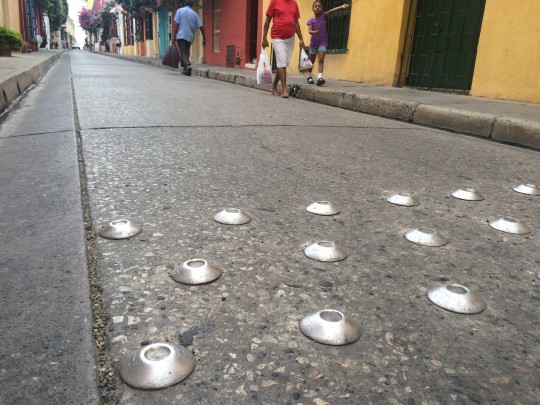
Too broke to pay for textured pavement? Yeah, so is Cartagena. But these simple pavement studs do a similar job well enough for much less.
3) Bus rapid transit
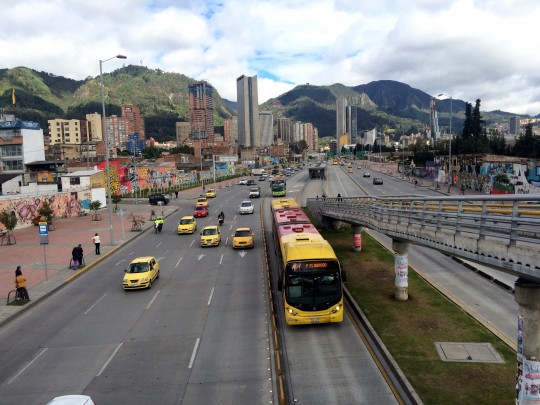
Speaking of doing the job well enough for much less, Bogotá’s TransMilenio system is as much a triumph as everyone says. After decades of failing to build a public rail system — can you imagine a city the size of Chicago with no major rail transit? — Bogotá in 1998 decided to steal a cheaper concept from Curitiba, Brazil. It was a bus line that functioned like a traditional rail line, complete with dedicated lanes, limited stops, highly visible stations, frequent all-day service, big bendy vehicles and payment before boarding.
The much-imitated TransMilenio would be worth very little without its dedicated lanes, just as the Portland bus rapid transit lines Metro is planning now on SE Powell and Division and considering for SW Barbur won’t do much good if their buses still have to sit in traffic.
It’s because of TransMilenio’s bus lanes that you’d be a fool to try to get around Bogotá by car unless you had to. TransMilenio’s ridership shows it. Its stations pack to crush capacity each day with riders of every class.
TransMilenio has downsides; even its well-built Volvo buses are bumpier than rail cars would be. But when BRT works, it works. It’s great that many U.S. cities are figuring this out.
4) Fold-out storefronts
Aren’t these clever? Much like food carts that turn Portland’s former parking spaces into economic engines, each of these metal pillars folds neatly out into two sidewalk shops (one on each side) during busy times of day.
Admittedly, most of them seemed to be selling the same 39 or so items, and the whole system depends (like much of the Colombian economy) on many people being willing to not make a lot of money per hour. But as space-efficient ways to bring commerce and convenience to a street, these are terrific.
5) Gondola transit
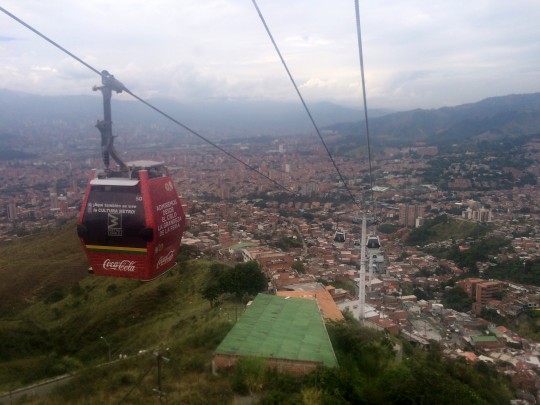
What a good idea.
Portland, of course, has an aerial tram connecting the South Waterfront to Oregon Health and Science University, and when I heard that Medellín had a gondola system I pictured the same thing: a big floating room going back and forth every few minutes with a dude inside shouting “la cabina se moverá cuando pasamos de la torre” all day, every day.
Medellín’s Metrocable system, introduced in 2004, is different, in a way that I hadn’t wrapped my head around until we used it: the cars are tiny and arriving constantly. Portland’s tram works well for its job, but there is a big psychological difference between a 79-capacity car every three minutes and an eight-capacity car every 15 seconds. It’s basically the difference between breaking stride and not breaking stride.
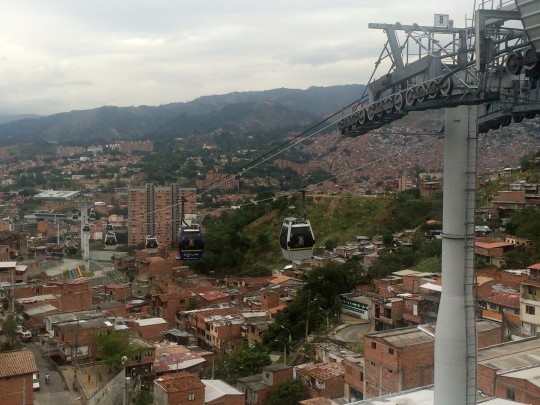
Another huge thing: Because Metrocable cars aren’t individually staffed, Metrocable can offer 15-second headways without high operating costs. At least until the self-driving bus is perfected, the best bus system in the world will never be able to arrive as frequently as Metrocable. All those bus drivers would just be too expensive.
As it is, Medellín (a city about the population of Portland but much denser) is able to maintain a public transit network with five lines of fast-moving, constantly arriving vehicles linking 13 stations. It’s a perfect add-on to the city’s larger rail network, and it’s allowed Medellín to leap gracefully to the far side of a mountain, into another valley, and build a transit-oriented middle-class suburb up the side of a second mountain:
6) Routing ciclovía through a pedestrianized area
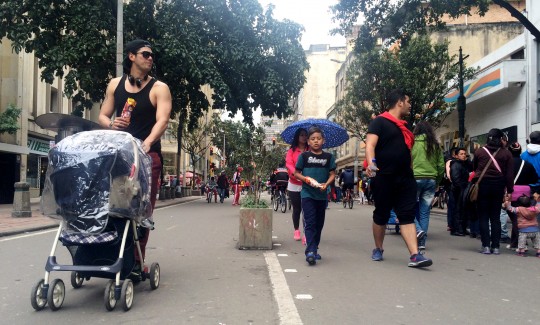
Colombia’s No. 1 claim to fame in the U.S. biking world is the weekly open-streets festival it calls Ciclovía. We got to see two in Bogotá. I’d expected them to offer something lots of us have yearned for from Portland’s Sunday Parkways: the joy of riding car-free on big commercial streets. But I didn’t realize that it’d also offer a related combo: an open-streets event on a street that is already car-free almost all the time.
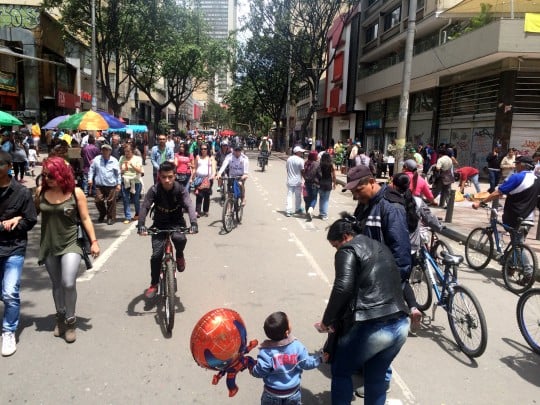
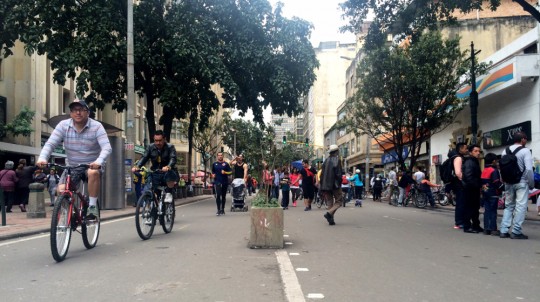
That was the case on Carrera 7 in central Bogotá. By pedestrianizing a network of streets throughout the city, the weekly festival makes this street even livelier than it usually is — notably by opening the streets up to free, minimally restricted commercial uses. Given the flow of people pouring past, Bogotanos came up with hundreds of ways to bring the streets to life, from living statues…
…to pay-to-jump trampolines…
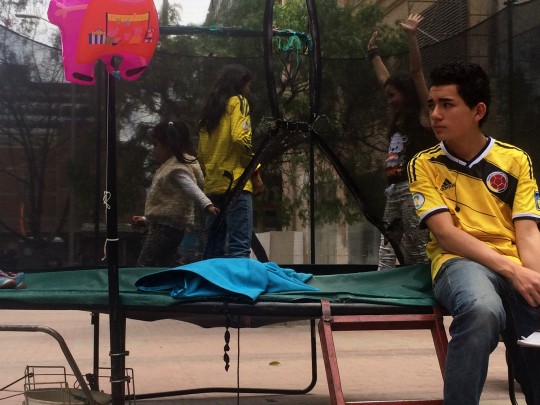
…to sidewalk sales of every variety (the sign on the right says “clothing for your pet,” which rang familiar)…
…to musical performances in a bus shelter…
(I think there may be some disagreement within this band over whether the guy on the right is supposed to be the frontman or the guitarist with mystique)
…to games for kids. (And looking back at this picture, I have to say: those are some legit Bogotá leg muscles.)
7) Pedestrianized spaces in general
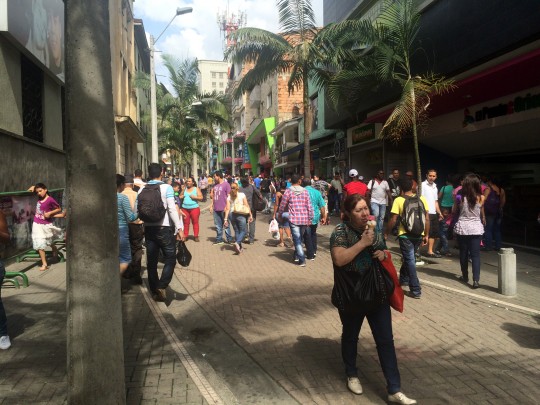
To run Sunday Parkways through a pedestrianized space, of course, we’d need some pedestrianized space. And with a few small exceptions, Portland is sadly lacking in it.
To be sure, pedestrianized areas are harder to make work in a city as rich as Portland, where most people own cars. In any case, I was impressed by the number and liveliness of city streets in central Medellín and Bogotá that are either closed to cars…
…or built and used in a way that made it clear that motor vehicles were guests.
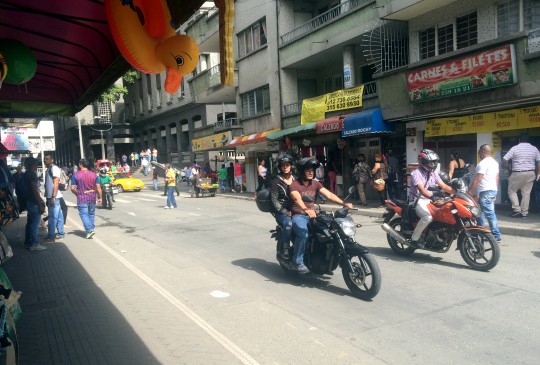
The street below offered several continuous blocks of bookstores, essentially creating an open-air Powells under multiple owners.
8) Private buses
This isn’t unique to Colombia; lots of developing and middle-income cities are flooded with private buses sometimes called colectivos. The one above, in Medellin, was wrapped in ribbons to celebrate the Feast of St. Christopher, patron of bus drivers.
Here’s the thing about Colombia’s private buses: they spew thick pollution, weave unpredictably between lanes, and are frequently disintegrating inside. They lack unified fare systems or reliable schedules, and in some of them the driver is also the fare collector, which means he’s trying to make change while zooming down the street. This is dangerous.
And yet … the fares are cheap (about 50 cents) and the buses are arriving all the time.
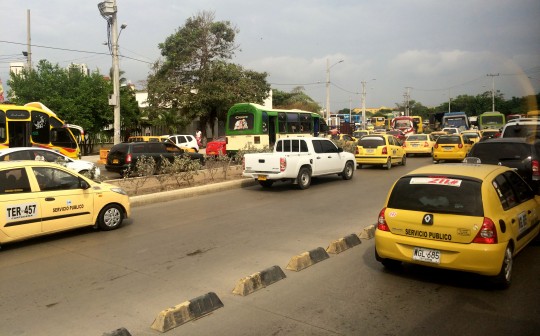
Above is a typical scene from a thoroughfare in Cartagena, which unlike Medellín and Bogotá hasn’t yet attempted to replace its private buses with public ones. Unlike the impenetrable database of numbers you have to memorize to understand, say, TriMet’s system, Colombia’s private buses are models of usability, their windshields colorfully marked with their route and destinations.
Here’s a U.S. transit rider’s dream: the best of both worlds. Private bus operators would pay TriMet for a set of basic services: curbside access to bus stops, a unified fare system and a shared arrival-tracking server. Then they could get licensed to run whatever routes they like during whichever hours they could make money. The public could keep operating our own system, or just subsidize certain routes and riders.
Portland saw a private bus boom during World War I, but streetcar companies convinced the city to drive the upstarts out of business. Could private mass transit work again? We’ll never know until we stop making it illegal to try it out.
Advertisement
9) Prefab half-benches
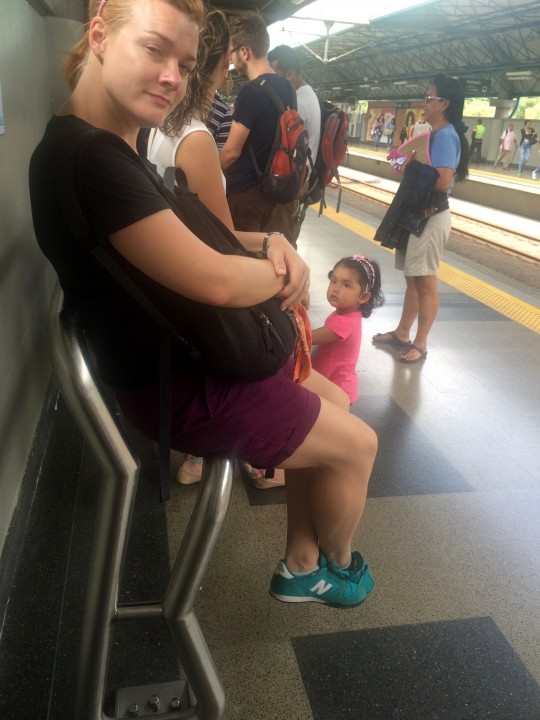
Want to give people a place to sit, but not sleep? These metal pipeworks are all over Medellín’s rail stations. I expect the shipping costs are pretty high, sadly.
10) Linear parks
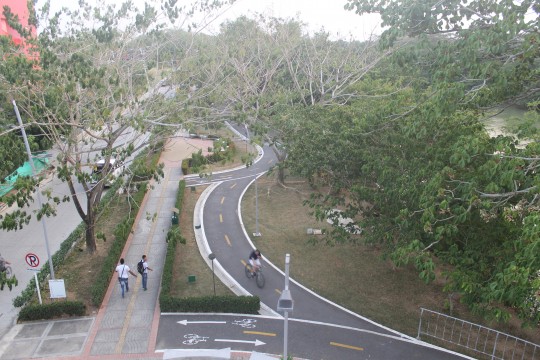
(Photo: Amnerys Marieta Pérez Coronado)
I didn’t manage to get any good pictures of my most surprising discovery in Colombia, because we were in a rush to catch a plane. It was a miles-long chain of seemingly Dutch-quality bikeways along a river in Montería, a city of 1 million near the Caribbean coast that I’d never heard of. The bike paths transitioned seamlessly into protected bike lanes through a major commercial district and ran all the way to the airport. We were there near the end of a Friday rush hour, and they were packed with riders.
I later figured out that we’d accidentally stumbled across the Ronda del Sinú, the longest linear park in Latin America and the centerpiece of the bike network in Montería — a city that apparently has a biking mode share of 12 or 13 percent, making it one of the most important bike cities in the Western Hemisphere.
All of which is especially exciting because Montería would be the hottest bike-friendly city I know of. Year round, its average highs are in the 90s, its lows in the 70s. (Bogotá, by contrast, has the dry air and drizzly cool of Portland, Amsterdam or Copenhagen, thanks in its case to its altitude.) If I ever get back to Colombia, Montería will be at the top of my list.
11) Public murals
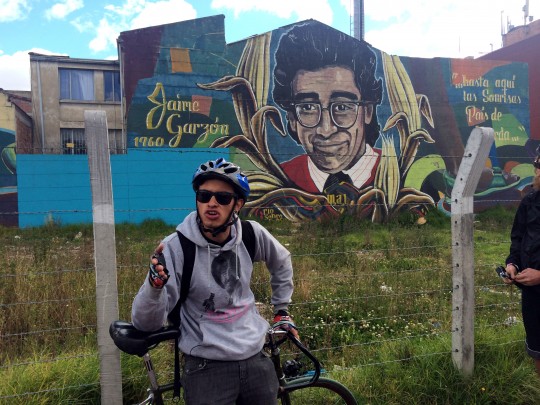
OK, this final item is not directly transportation-related, though public art definitely helps make a city feel more human-friendly. And of course I’m far from original in praising Bogotá’s street murals.
But still: they are spectacular.
This series seems to have been a collaboration between two or three artists along a major street.
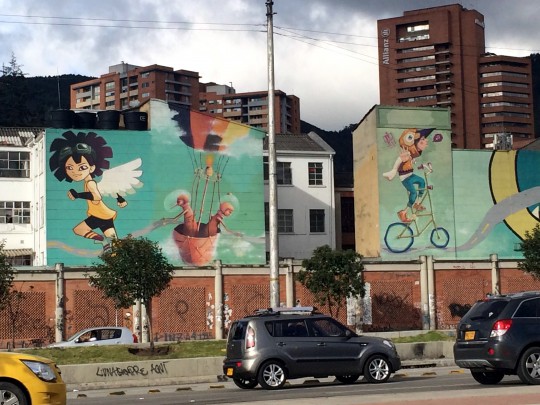
Here’s another impressive sequence, from left to right:
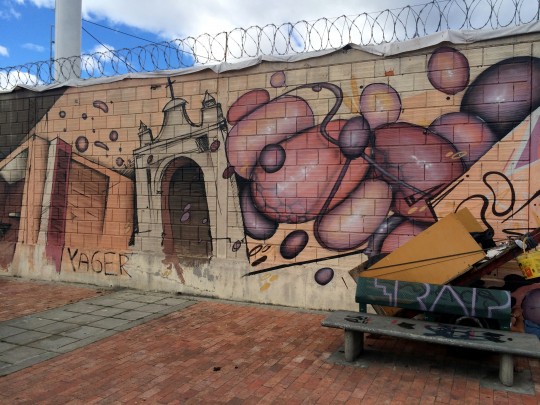
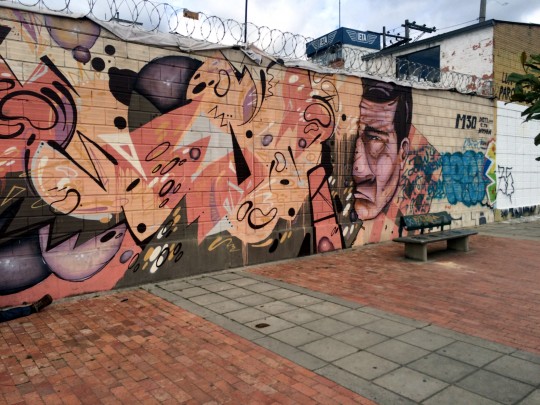
In some cases, Bogotá’s murals are a sort of public education: ways to pass on pieces of the city’s history and values to the millions who’ve arrived only recently.
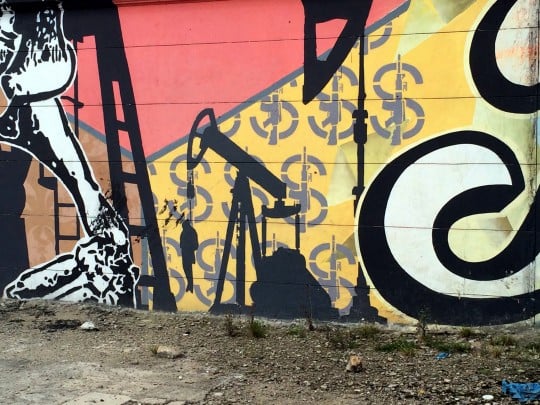
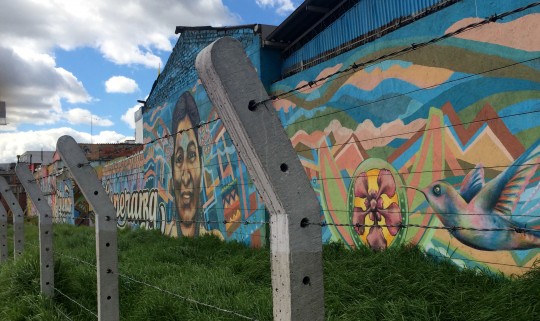
In other cases, they’re just memorable decorations for the garage door of a closed storefront.
On our last days in Bogotá, we came across this mural a few times in various stages of installation:
More than anywhere I’ve been in the States or Europe, Colombia’s cities are bursting with change. There’s a construction project around every third corner. This isn’t all good (I was amused to find a horrified column about “uncontrolled urbanism” in the Medellín equivalent of the Northwest Examiner) but it gives you a palpable sense of a country on the rise. Armed with ideas like these, Colombia very clearly is.


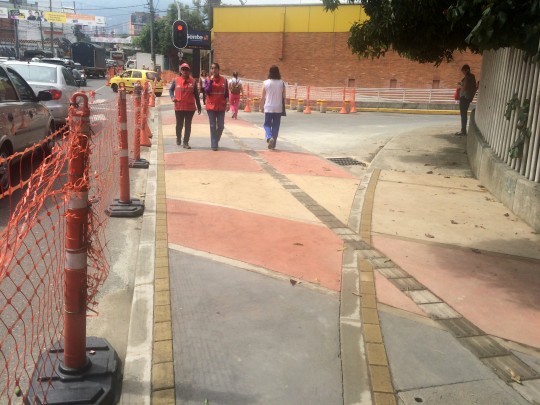
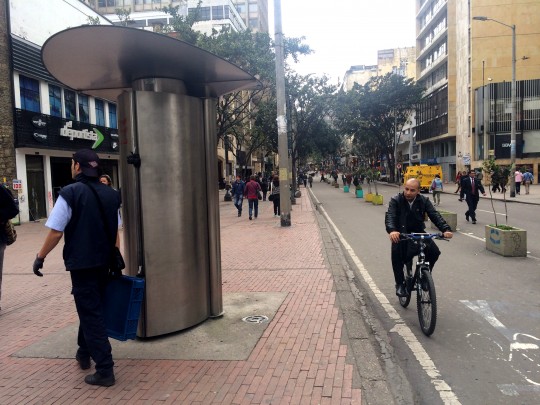
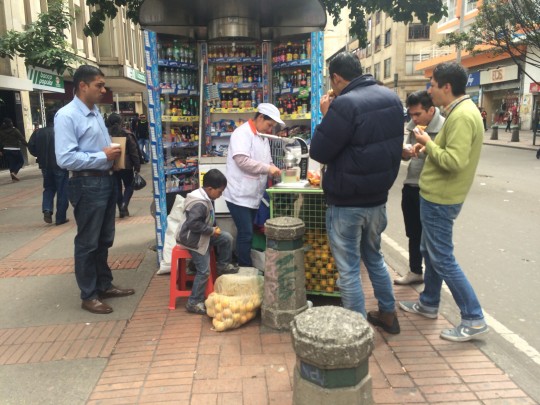
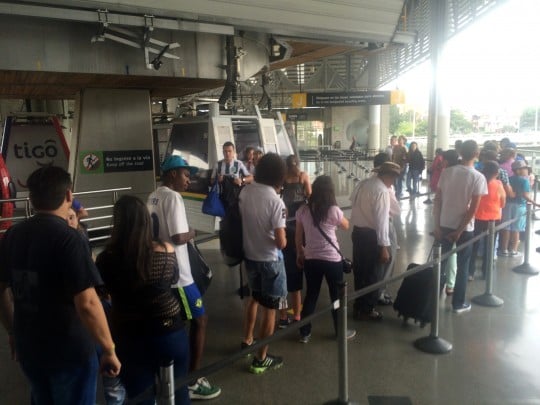
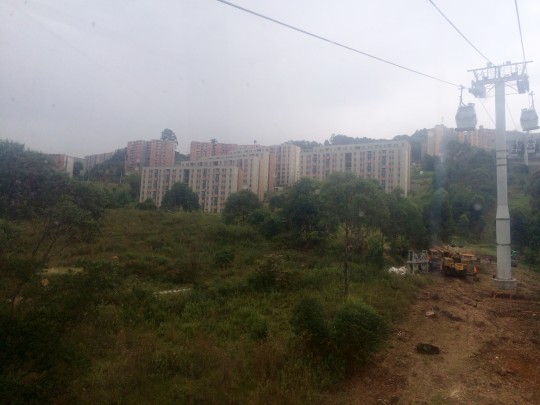
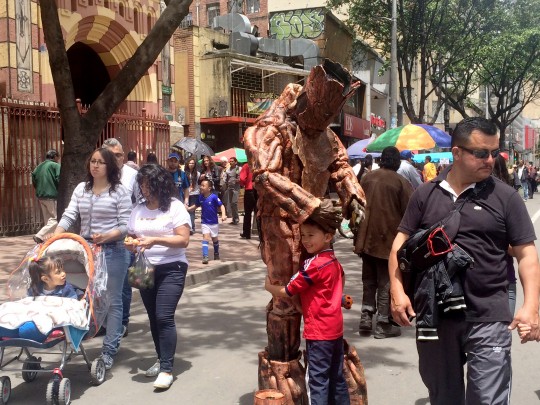
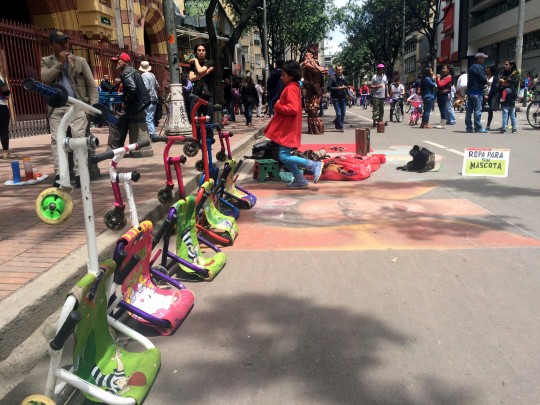
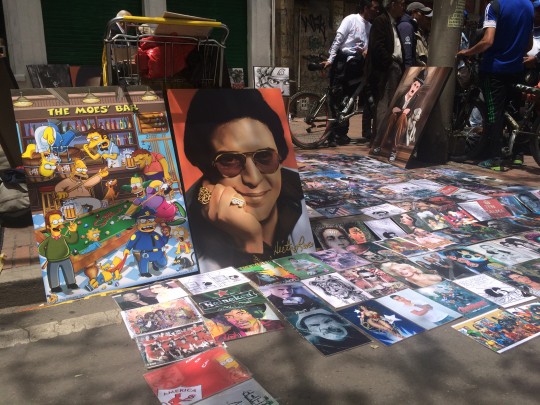
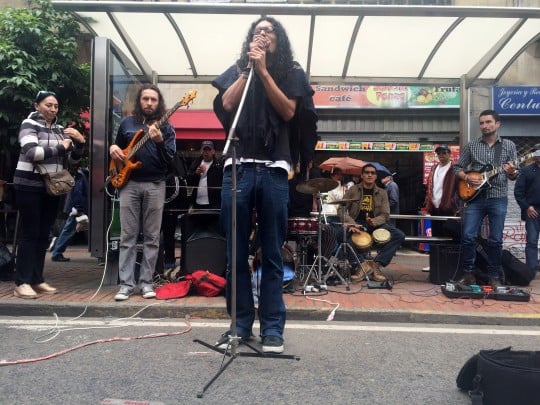
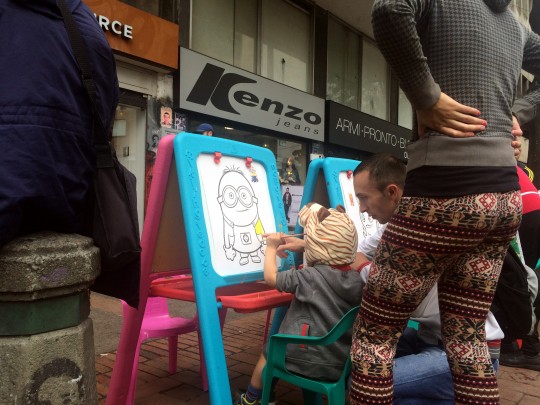
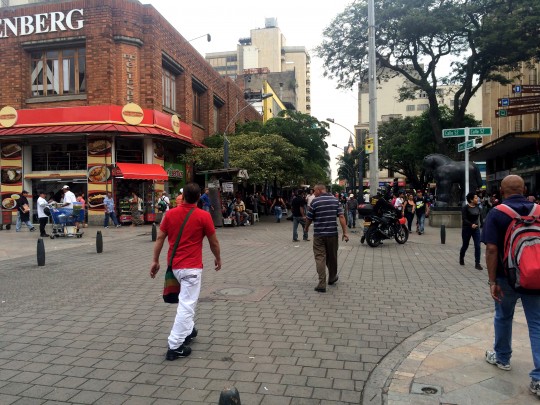
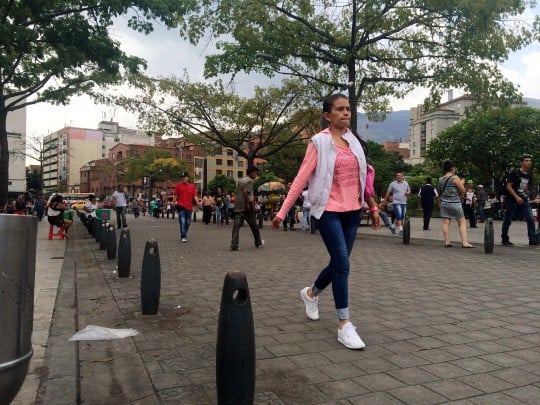
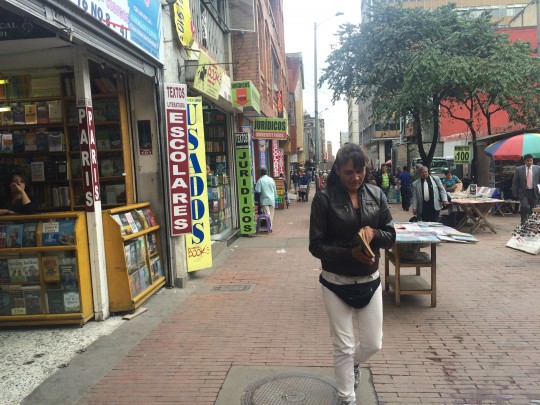
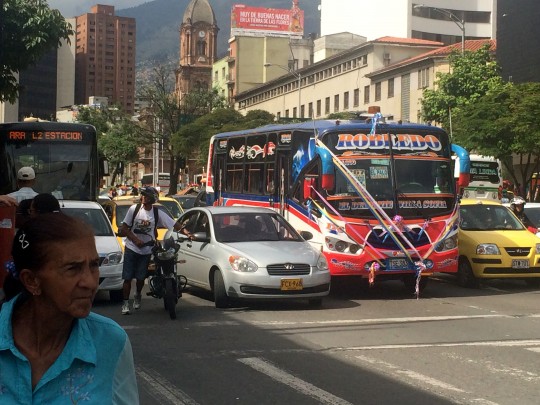
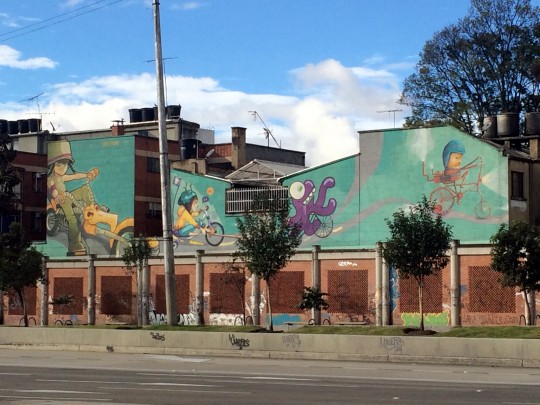
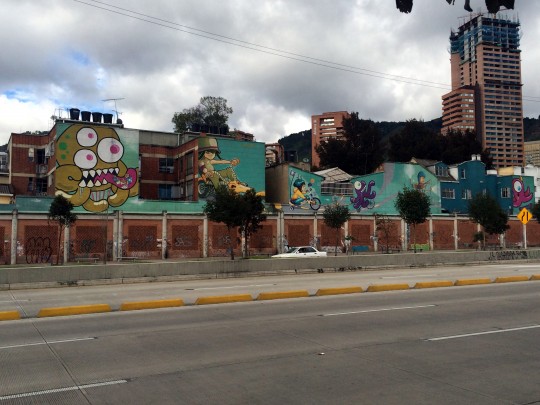
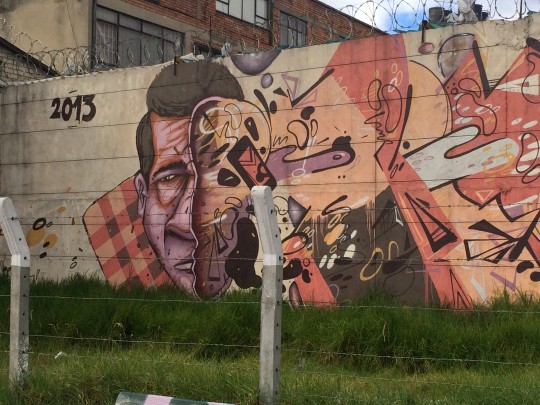
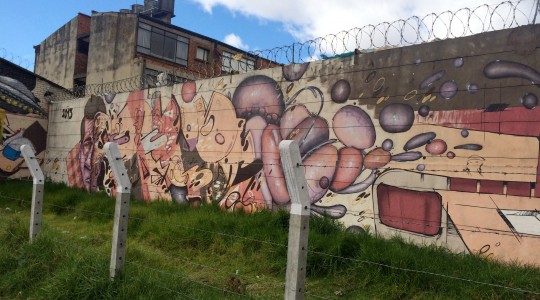


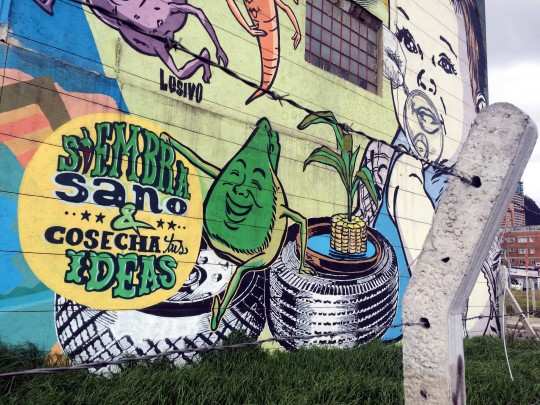
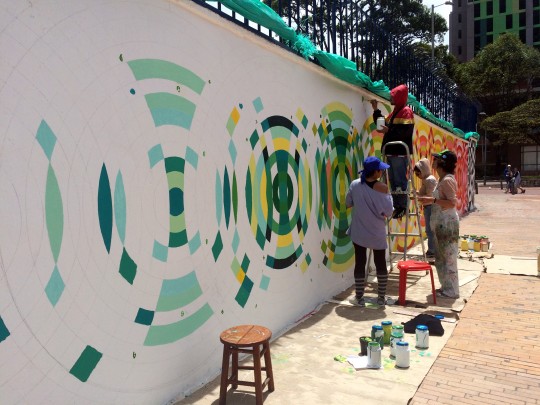
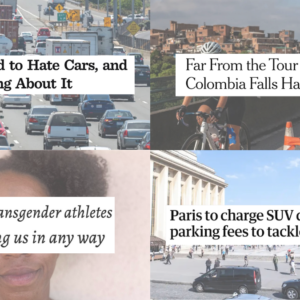
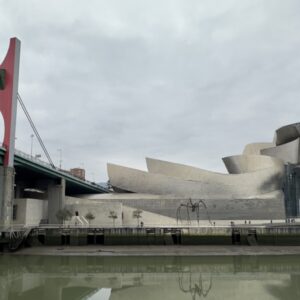
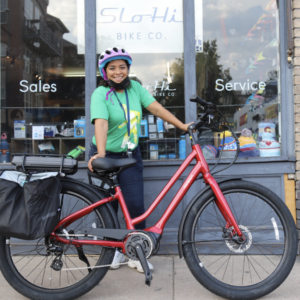
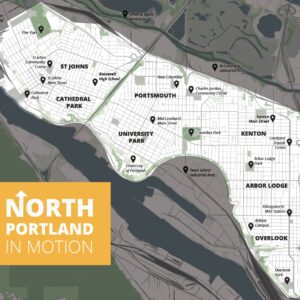
Thanks for reading.
BikePortland has served this community with independent community journalism since 2005. We rely on subscriptions from readers like you to survive. Your financial support is vital in keeping this valuable resource alive and well.
Please subscribe today to strengthen and expand our work.
more on Medellin – the cable car goes up into the poorest part of the city, and makes it possible for workers to get to work in a fraction of the time it took before.
also, in Medellin, you’ll see people in jumpsuits, cleaning up trash and so on. The city gives these jobs to low-income/homeless people who need them.
Don’t forget about the escalators!
https://www.youtube.com/watch?v=UhhUCP7Ov24
Totally – we tried to make it to one of these but failed, so they’re not included here. But yes.
Yes! The line to Comuna 13 was closed when we were there, unfortunately – which, now that I mention it, sounds pretty inconvenient for the folks in Comuna 13 – but the Metrocable is a great way to build excellent transit into a hillside full of informal/illegal homes without demolishing them.
I like the idea of the metrocable serving transportation needs of Medellin’s poor people living up in the hills. In Portland though poor people tend not to live up this city’s hills, but instead, people with rather good to very good incomes, nice houses and cars do.
If it was found important to increase regularity of departure arrival times, the Portland Tram could possibly add some of the smaller, lighter lower capacity tram cars to its service between the OHSU complex on the hill, and the waterfront.
I don’t think it’s “dumb” necessarily, that US urbanists focus so hard on Europe. I think it’s a blind spot, as most people probably assume that South America is a horrible wasteland of backward people with dirty slum-filled cities with nothing to offer us by way of urban transportation ideas.
And you know what happens when one assumes…. I do think that urbanists should read your series, visit the cities, and come back with ideas such as you’ve discovered.
Part of the problem is most of us either don’t think about South America OR we just think of it as ‘that place with drugs and war’. Much how instead of a group of countries with varying cultures and climates Africa is just ‘that place with war and AIDS’.
We associate with Europe because we’re world powers, we fight wars, we can trace bloodlines back, we’re wealthy, and let’s face it, most of us are white.
Thank you for this series Michael! Great photos too!
Thanks for sharing Michael. I rode the BRT in Quito in the early 00’s, and it was awesome. Looks like a rad trip. The ‘Bolivar’ countries could teach us many things about urbanism.
Thanks for this series, Michael!
Asia is also full of fascinating urban innovation. When there are huge populations and lots of people can’t afford cars, cities figure this stuff out.
The huge presence of bicycling, rickshaws, shared vans and buses, trains, and places to walk throughout places like India, Vietnam, Malaysia, Cambodia, Indonesia, etc. is largely ignored when we look at “world’s best” practices for boosting transportation choices.
Some of that is racism, some of it classism, some of it blind spots from where consultants and decisionmakers travel (or don’t travel), while other parts are the results in highly regulated contexts where we outlaw certain things in attempts to provide more safety, higher wages, dependability, etc. The unintended consequences of much of that regulation are visible when one travels.
You are absolutely right Michael, thank you for this great report! We should look places that don’t have a 15% tax rate in order to pay for beautiful infrastructure, since that is not happening in America. Also Europe is a bad example because they have such a tiny area for each government to govern. We have so much space here, so many cities, its hard to make a dent in anything.
We have a mental block on lively pedestrian areas however because in places you mention people live right in the center and have tiny refrigerators and need to walk every day for food and supplies. Americans can’t quite seem to get over our big ass refrigerators and weekly shopping. It takes more than a bagel and coffee shop to keep a pedestrian area lively as countless planning literature shows.
Had a thought though – the Pearl Dist. With so many people living in the towers and walking around why do they need all those streets to go through? We should close a few more, the area is a nightmare to drive through anyway.
Question: press on traffic calming – size?
Raised crosswalks = speed bumps = emergency response delay.
I’d say about three inches diameter. They didn’t seem to cause any trouble for bike tires, though we didn’t ride bikes ourselves in Cartagena.
So about the size of a circular, non-reflective, raised pavement marker, but maybe a little taller. Doubtful these would have much effect on speed. The road in the picture looks to be about alley size in US terms. two autos approaching each other there would very much need to slow down.
Rumble strips have been tested in Portland. They are typically glued to the street (asphalt doesn’t hold lag screws very well). They are difficult to maintain, as the attachment method is poor at best, and the noise generated is disruptive to those that leave windows open in the summer. A concrete pad would help, as might larger versions (aka, turtles), but then you get into hazard issues if a cyclist, or motorcyclist, strikes one.
Like most Colombian urban streets, this was a one-way — in this case a one-lane-one-way because it’s in the 1600s part of the city.
The problems you cite make good sense, though I’d ask:
– Doesn’t textured pavement tend to have a traffic-calming effect? That’s not an issue of physical obstruction.
– If you think these are ineffective, why do you think they’re being used?
Textured pavement is usually quite benign and mostly decoration with color added. If you mean cobblestones and older such pavement materials, it would depend on the difference between the high and low spots and how close together those features are. The more effective for reducing auto speed the less comfortable a bike ride.
As to the features photographed, could you tell how they were attached? The top looks like it could be a lag screw counter sunk with clear epoxy filler, but clear doesn’t make sense to me. Did you see them at night? They might be illumination of some sort.
Yeah, I guess I just meant non-smooth brick – enough to hear in one’s car, the way one would be able to hear these.
I futzed with them briefly but couldn’t figure out how they were attached. We did see them at night and I don’t think they were illumination, though that’s a good guess.
Are there any studies looking at the potential increase from raised sidewalks due to delayed response time vs. the number of traffic fatalities due to inadequate crossing facilities and speeding traffic?
I question this because the safest cities in the world (that typically lead in lowest traffic deaths and lowest preventable health-related deaths) tend to have pedestrian treatments such as raised sidewalks.
Either way, I don’t think you can dismiss raised sidewalks with “emergency response delay”. We don’t know that it is necessarily a negative thing. Plus, that can lead you down a rabbit hole of potential solutions. Do we need congestion charges to improve emergency response time? Do we need dedicated lanes for emergency response vehicles?
Chris,
The established delay to fire trucks and engines per speed table is in the 9-10 second range. Traffic calming in Portland is limited to Local Service and Neighborhood Collector streets for the specific reason that such roads are rarely Major Emergency Response routes. Portland Fire and Rescue is the primary responder to all forms of emergencies, not just fires. As any ambulances they might have only carry 2 EMTs, and OSHA rules require 4 at a medical response, a fire truck or engine must respond in every case.
So the trade off is not just crashes reduced, but also all other medical emergencies that could be affected by delay.
Responding to how many injuries caused by wide and fast streets?
Ten seconds!? Is that from a real study or some math? Please show your work. Even slowing to 10mph from 40 would cost less than 7.5s if you spend 10s to slow and accelerate. That’s “don’t want to spill my coffee” driving, not emergency response. What’s the average hold time for 911 these days?
But speed tables as crosswalks are indeed more useful than speed humps, which basically just make neighborhoods noisier. The bigger question for emergency response is how do we make traffic diverters to create quiet streets without increasing response times?
Many cities have studied this, Portland, Austin, Berkley, Bellevue.
http://www.portlandoregon.gov/transportation/article/85498
contact 823-SAFE for a copy of the Portland study.
Speed tables and raised crosswalks are much less effective at slowing speeding autos than speed bumps/humps are. Not sure where your assessment of speed bumps making neighborhoods noisier than speed tables comes from. Any studies you can show us?
You’ll need to ask the fire bureau about their statistics. They publish a report every few years.
And – are there any studies about the overall effect of that delay on public health? I always wonder if the public health effect of emergency response delay is far more/less than the public health effect of increased activity due to more biking/walking and less serious crashes….
Some sources more suspect than others.
https://www.portlandoregon.gov/fire/article/388484
http://onlinelibrary.wiley.com/doi/10.1197/aemj.9.4.288/pdf
http://openheart.bmj.com/content/2/1/e000201.full
http://www.johnlocke.org/acrobat/policyReports/trafficcalming-brief.pdf
And yet every driveway (good ones anyway) are designed like these ‘raised crosswalks.’ We have examples scattered across Portland of street entrances designed like driveways – they work, and we should have more of them.
Nick,
Driveways are not roads. Complete non-sequiter.
Check out SW Multnomah, where the “bikeway” dips down into every driveway as if the driveway were a road or maybe just to remind you “people with cars are important”.
I’ll repeat the second half of my post: We have examples scattered across Portland of street entrances designed like driveways.
Raised crosswalks (not the crappy speed-hump kind) are present in Portland, and they work wonderfully. I’ll send you a map of them if you’d like.
Here is a map of some raised gateway crosswalks in Portland. These are not driveways, they are public streets turning onto public streets.
Anyone know of more? I’d like to add to this:
https://www.google.com/maps/d/edit?mid=z9IGcHeBBHSk.kzx2XXk8pg0U&usp=sharing
I enjoy many of these and they are good or great even. But if we’re throwing around the word ‘dumb,’ I’d argue he dumbest of all would be the adoption of privatized buses. A nuisance here in Colombia and if they’re incentivized by quantity (as they are here)! the U.S. Would find out soon enough that they’re a very real safety issue and incredible burden on traffic.
Not as incredible a burden on traffic as they would be if all those passengers were in cars!
But I agree, duplicating Colombia’s existing private bus system would be dumb. My argument is that it’d be possible to get the good parts without the bad.
If you allow private buses, won’t they end up taking the profitable routes and leaving the less profitable ones for the public to subsidize? I see a total collapse of public transit down that way; it would prevent the implementation of service to locales that aren’t yet dense enough with riders to pay enough of the cost of service to make it happen. Soon enough, everything stagnates.
Yep, private buses would poach the most-ridden routes if they were allowed to.
But here’s the thing: in Portland, everything except the MAX lines and maybe the No. 72 are already unprofitable. (And even MAX, of course, would be catastrophically unprofitable if you counted the $7.5 billion or so that was required to build it.) A tiny slice of our payroll taxes cover 80% of TriMet’s operating costs.
That’s fine! Mass transit is a public good. Our payroll taxes should be subsidizing it. But even if TriMet had a handful of profitable bus lines, it could ban private buses from operating on those and declare the rest of the city fair game. Every run of TriMet’s marginally unprofitable No. 15 that TriMet could offload to the private sector would give the agency a few more dollars to spend making its wildly unprofitable No. 34 better.
Or, if you wanted to go one step closer to the current system, TriMet could put out contracts and people could bid to serve certain transit routes. Upside is greater public control; downside is that you wouldn’t let entrepreneurs invent their own routes, which would be the main benefit of private buses.
Theres something you photographed that you probably didnt even think about. Note your second and third picture, that yellow strip in the sidewalk?
It’s for the blind. And it makes a whole lot of sense. In the USA, we have bump strips (tactile domes) at every corner. They offer very little information. All they say is “cars cross here”. They offer no direction at all. Nothing.
Meanwhile, those yellow strips actually allow the blind to navigate. They can follow them in the path that is clear (no trash cans etc). At junctions, bumps indicate they have multiple options. At corners, a different set of bumps indicate a roadway.
I knew Japan and Brazil have them everywhere. I didnt realize Colombia did as well.
Isnt it so sad that when it comes to helping the blind navigate, the USA is completely outdone by Colombia?
Here is an example of a subway station in Brazil, where the blue navigation aid helps the blind find the subway door. Compare in the US where all we tell them is “theres a track hole here”
Great catch.
“As it is, Medellín (a city about the population of Portland but much denser) is able to maintain a public transit network with five lines of fast-moving, constantly arriving vehicles linking 13 stations…”
I believe, Medellin has something as high as 3.5m depending on how you draw the boundaries.
Fantastic, eye-opening article and pictures, Michael. I loved looking at all the pedestrians, cyclists, and art in the streets.
Raised crosswalks might have been cheaper than replacing all of our old street corners 20 or so years ago with the ADA compliant sloping corners. BUT they would probably interfere with rainwater drainage in many places. AND in climates with snow, that sloped side could cause problems for cars trying to get going after stopping at an intersection – not to mention it would be somewhat of a hazard to pedestrians if it was slick due to ice/snow/winter slime/etc.
Portland, like many cities, restricts the placement of speed bumps and tables based on street grade. Portland does not construct bumps on grades over 8% and does not construct tables on grades over 12%. Portland has two types of raised crosswalk. One type meets the curb and a shallower ramp is provided as a cue to those with vision issues. The other type uses a standard ramp but uses a wide edge taper to ease the path onto the crossing for wheelchair users.
Drainage is an issue if the gutter is blocked. Relocating catch basins is $1,000-$2,000 each. Alternatives include a pipe or covered channel at the gutter line.
We have a linear park! Yeah, it’s not so awesome with the yellow stripes and unchecked speeding traffic. I think it’s also our only parkway (yet not in Sunday Parkways.)
http://www.portlandoregon.gov/parks/finder/index.cfm?&propertyid=793&action=ViewPark
Fun stuff. It will be interesting to see how “BRT” rolls out on Powell and Barbur…if it does indeed. Maybe you will need to get out there and paint some murals and sell arepas at the bus stops Michael.